If you ask most consumers what breeds of cows have horns, many disconnected from agriculture would respond that bulls have horns and cows don’t. This seems logical and hard to disprove because most dairy cows in milking form or in pictures have no horns. The practice of dehorning has been performed over many years to protect cows from injuring other cows and the farmers that care for them. Dehorning is a common practice on dairy farms. However, it is something farmers do not like to do, and even with a variety of different methods, none can claim a pain-free procedure.
Consumer concerns and animal welfare issues are encouraging protocols that require pain control and early dehorning of calves. Polled genetics are a drug-free and labor-saving option to reduce or eliminate
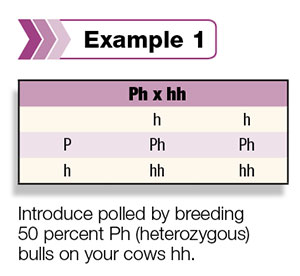
dehorning.
How polled works
Polled is a dominant trait. If an animal receives at least one polled gene from one parent it will show the polled phenotype of “no horns.” The horned trait is recessive.
An animal needs a copy of the horned gene from its mother and father to show the phenotype of horned.
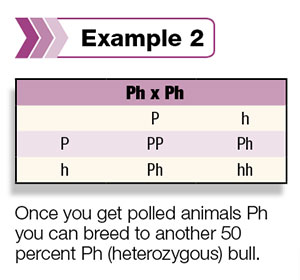
Traits that are dominant are easier to breed for and maintain in your herd. The trait can be introduced in one generation.
The terms used to describe polled animals are heterozygous polled and homozygous polled.
To simplify, heterozygous means an animal has both the polled and horned gene – call them 50 percent polled or Ph.
Homozygous means the animal has both polled genes; they are called 100
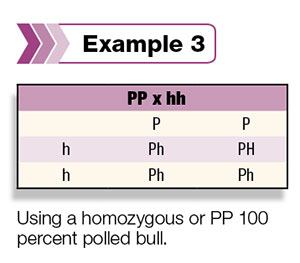
percent polled or PP.
We can use both Punnett squares and coin tosses to simplify how the dominant polled gene works and the phenotype or proportions of polled status of calves from matings.
Just like flipping a coin where heads is polled, fifty percent of the time you get polled (heads).
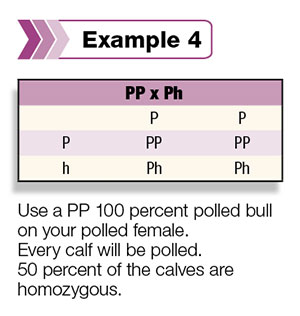
This is like tossing two coins. Having both coins flip heads would be homozygous polled. Two tails is horned – no polled gene.
Having one of the coins heads and the other tails is heterozygous or 50 percent polled.
If you try this yourself with enough coin flips, you will come close to the ratio of 25 percent PP, 50 percent Ph and 25 percent hh.
This is like having a two-headed coin. Every flip gives you polled (heads).
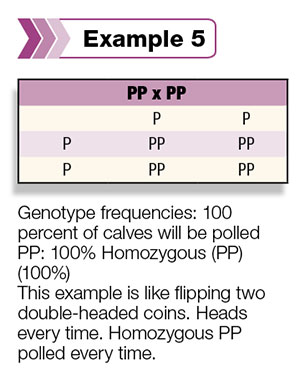
This scenario is like having one coin double-sided heads. The other coin is regular (heads or tails). Flip both coins.
You are guaranteed polled because the bull is homozygous (100 percent polled PP).
Fifty percent of the time the other coin will be heads, making your own PP homozygous animals.
The other 50 percent of the time you still have one polled. Again, from this mating every calf will be polled.
This example is like flipping two double-headed coins. Heads every time.

Homozygous PP polled every time.
Why is polled taking off now?
This is not something new. Polled bulls in Holsteins can be traced back to the early 1900s. There are some polled animals in the six major dairy breeds – Holsteins, Jerseys, Brown Swiss, Ayrshire, Guernsey and Milking Shorthorns. Some of the breeds used for crossbreeding, like Norwegian Reds, Fleckveih, Normande and Danish Red, also have polled animals.
There have been many dedicated breeders developing the polled trait over the years. Two things have been rapidly changing the interest in polled:
1 . In 2009, the commercial testing of polled status was made available – In 2012, a test that identifies the actual causal mutation is available from Germany. This has allowed verification of polled animals that may have been accidentally dehorned and, more importantly, allows for the identification of the 100 percent polled animals with both polled genes (100 percent PP/homozygous).
This had been verified previously by observing polled status of offspring out of horned animals. A bull needed at least 10 polled calves out of horned cows to be called 100 percent or homozygous polled. This would be discovered after a bull went through a progeny proving program, and it would take three years. With the one- in-four odds of being homozygous and the cost to put animals through progeny testing, it did not result in many 100 percent PP bulls discovered historically.
2. Genomic testing of young animals – The ability to identify animals’ genetic potential at an early age has been beneficial for advancing polled genetics. In the past it was difficult to get bulls into A.I. if they were sired by young bulls. The influential polled Holstein bull, Aggravation Lawnboy, was syndicated by the breeder Bob Feldwich because A.I. studs were not interested in sampling a polled bull sired by a young sire.
He instead was sampled through Sunshower Genetics. After receiving a proof, Lawnboy was later purchased by Select Sires . Genomics now has increased the accuracy in young bulls. In the horned population, high-genomic young bulls are being used as sires of sons. There is an increasing trend in the use of genomic bulls. This now levels the field and has advanced the polled gene also by reducing the generation interval.
Interest in polled genetics is high. Many breeders are introducing polled bulls into their breeding programs. The selection and quality of polled bulls has improved. At the same time, animal welfare and the need for labor efficiencies on-farm have also increased.
I encourage people interested in polled to do some research online or contact A.I. suppliers to inquire about polled options. The quickest way to introduce the polled gene is to use 100 percent polled or PP homozygous bulls. This gets a base of animals polled. Fifty percent polled bulls will get you started as well, but be aware, half of your calves will still have horns.
The first step is to start. Our knowledge of the genetics in matings being made and future availability of 100 percent polled PP bulls will assure you polled bulls for mating your polled animals. PD







